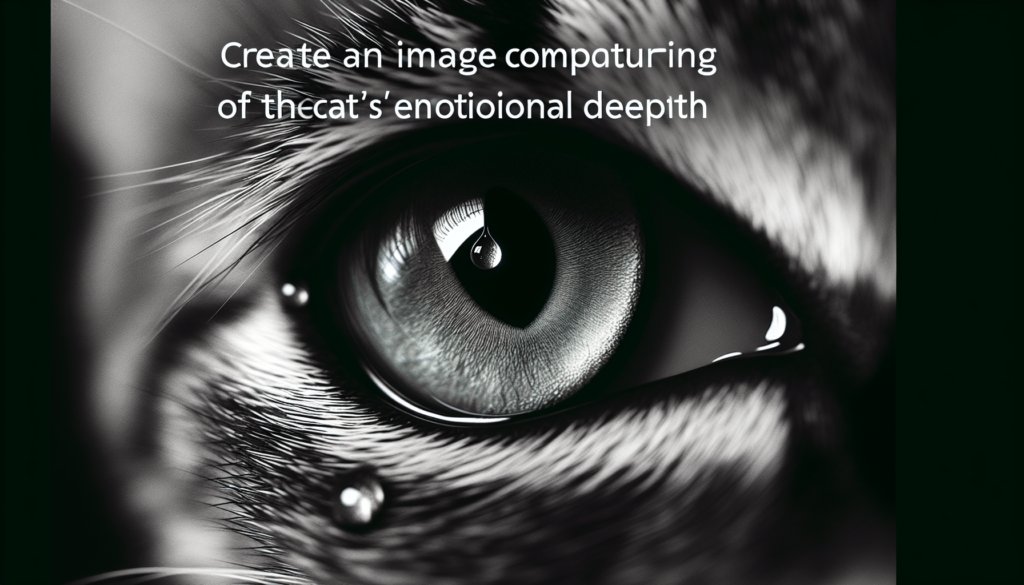Have you ever wondered if cats cry? You might be surprised to know that cats do shed tears, but not necessarily due to emotions like humans. In this article, we will explore the fascinating world of feline tears and uncover the truth behind their mysterious crying behavior. Whether you’re a cat lover or simply curious, this insight into the teary-eyed nature of our feline friends is sure to captivate your interest.
Understanding Cat Emotions
Cats are complex creatures that experience a wide range of emotions, just like humans. While they may not express their feelings in the same way we do, they still feel joy, fear, anger, and sadness. Understanding a cat’s emotions is key to providing them with the care and support they need.
Emotions in Cats
Cats have a rich emotional life that is influenced by various factors, including their environment, past experiences, and genetic makeup. Some common emotions that cats experience include happiness, contentment, fear, anxiety, and frustration. It’s important to recognize and respond to these emotions to ensure your cat’s well-being.
The limitations of feline emotion
While cats do experience emotions, it’s important to note that their emotional range may be more limited compared to humans. Cats‘ emotional responses are primarily focused on survival instincts, such as hunting, territorial behavior, and reproduction. This means that their emotions may not always align with human emotions, and it’s crucial to understand and respect their unique emotional needs.
Circumstances that may cause emotional stress in cats
Just like humans, cats can experience emotional stress in certain situations. Changes in their environment, such as moving to a new home or the addition of a new pet, can cause anxiety and distress. Other common stressors include loud noises, unfamiliar people, and veterinary visits. Being aware of these circumstances can help you anticipate and address your cat’s emotional needs.
Physical Symptoms: Do Cats Cry Tears?
When we think of crying, we often picture tears streaming down our faces. But do cats shed tears like humans do? Understanding a cat’s tear production and the reasons behind it can shed light on this question.
The anatomy of a cat’s tear ducts
Cats have tear ducts, just like humans, which are responsible for producing and draining tears. These tear ducts serve an important function in maintaining eye health by keeping the eyes lubricated and free from debris.
What it means when cats shed tears
While cats do produce tears, they generally serve a different purpose than human tears. Cats’ tears are usually associated with eye health and are produced to lubricate and protect the eyes. The amount of tears a cat produces can vary depending on factors such as breed, age, and overall health.
Common misconceptions about cats crying
It’s important to dispel some common misconceptions surrounding cats shedding tears. Unlike humans, cats do not cry emotional tears as a direct response to their feelings. Tears in cats are typically a result of eye irritation or injury, rather than an emotional response.

Common Reasons for Tear Production in Cats
Excessive tear production in cats can signify underlying health issues or environmental factors. Understanding the common causes of tear production can help you identify and address the root cause.
Medical conditions causing tear production
Several medical conditions can lead to increased tear production in cats. Common culprits include conjunctivitis, corneal ulcers, and blocked tear ducts. These conditions can cause discomfort and may require veterinary intervention to be properly treated.
Allergies and irritants causing tear production
Just like humans, cats can be allergic to certain substances, such as pollen, dust, or certain foods. Allergies can cause tear production as a reaction to the irritant. Identifying and minimizing exposure to allergens can help reduce tear production in cats.
Injuries and trauma leading to tearing
In some cases, excessive tear production can be a result of a physical injury or trauma to the eye. Scratches, foreign objects in the eye, or blunt force can cause tear production as a protective mechanism. Seeking immediate veterinary attention is crucial in such situations to prevent further damage.
Visible Signs of Distress in Cats
Cats are masters at hiding their emotions, but there are still visible signs that can indicate when a cat is experiencing distress. Recognizing these signs is essential for identifying and addressing your cat’s emotional well-being.
How to recognize a cat in emotional stress
Cats in emotional distress may display various signs that can serve as indicators of their feelings. These signs include changes in eating or sleeping patterns, increased aggression or timidity, excessive grooming, or withdrawal. Paying attention to these changes can help you gauge your cat’s emotional state.
Behavioral signs of distress in cats
Changes in behavior can be telling signs of emotional distress in cats. Increased vocalization, destructive behavior, litter box avoidance, or excessive hiding are all signs that your cat may be experiencing emotional stress. It’s important to observe these behaviors and consider the underlying emotional factors.
Physical signs of distress in cats
In addition to changes in behavior, physical signs can also indicate emotional distress in cats. These signs can include changes in appetite, weight loss or gain, excessive shedding, or changes in posture or body language. Recognizing these physical signs can help you address your cat’s emotional needs.

Differentiation Between Emotional and Physical Crying
It’s crucial to distinguish between emotional crying and physical crying in cats. Understanding the differences can help you better support your cat’s well-being.
How to distinguish between physical and emotional crying
Physical crying in cats typically manifests as excessive tear production caused by irritation or injury to the eye. Emotional crying, on the other hand, is not a common behavior in cats. Distinguishing between the two can be done by observing the context and accompanying signs.
Correlation between cat emotions and physical cry
While cats may not cry tears in response to emotional stress, their emotional state can still contribute to physical changes. For example, a cat experiencing fear or anxiety may show signs of increased tear production as a physiological response. Understanding this correlation can guide you in addressing both emotional and physical well-being.
Understanding the significant differences in the causes for crying
Recognizing the distinct causes for physical and emotional crying is essential in providing appropriate care. Addressing emotional distress requires a different approach than addressing physical issues. By identifying the underlying causes, you can better support your cat’s overall health and well-being.
Common Cat Behaviors That Are Mistaken for Crying
Cats have a wide array of vocalizations, each with its own meaning and purpose. While some vocal behaviors may sound similar to crying, it’s important to distinguish between them to better understand your cat’s needs.
The feline vocalization process
Cats use vocalizations as a means of communication. From meowing and purring to hissing and growling, each sound has a unique meaning. Understanding the vocalization process can help you interpret your cat’s message more accurately.
Identifying types of cat sounds and their meanings
Different types of cat sounds convey different messages. Meowing can indicate a variety of needs, from hunger and boredom to seeking attention or wanting to be let outside. Growling and hissing are often signs of aggression or fear. By identifying the types of sounds and their meanings, you can respond appropriately to your cat’s needs.
Typical causes for unusual vocal behaviors
Unusual vocal behaviors can often be attributed to specific causes. For example, excessive meowing may indicate that your cat is in pain or distress. Attention-seeking meows may occur when your cat wants your attention or is feeling lonely. Identifying the underlying cause behind unusual vocal behaviors can help you address your cat’s needs effectively.
Understanding Cat Body Language
Cats communicate not only through vocalizations but also through body language. Understanding their non-verbal cues can provide valuable insights into their emotional state.
Interpreting cat body language
A cat’s body language can reveal a lot about how they are feeling. The position of their ears, tail, and body, as well as specific movements, can convey messages of fear, aggression, relaxation, or contentment. Learning to interpret these cues will help you understand your cat’s emotional well-being.
Correlation between body language and emotional state
A cat’s body language is closely linked to their emotional state. For example, a cat with a puffed-up tail and ears flattened against the head may be displaying defensive behavior due to fear or aggression. Recognizing the correlation between body language and emotional state can help you respond appropriately to your cat’s needs.
Body language signs of distress or discomfort in cats
Certain body language signs can indicate that your cat is experiencing distress or discomfort. These signs include excessive grooming, dilated pupils, a tense body posture, or a tucked tail. Recognizing these signs can help you address your cat’s emotional needs and provide a comforting environment.
Dealing With A Distressed Or Uncomfortable Cat
If you notice that your cat is experiencing emotional distress or discomfort, it’s important to provide them with the appropriate care and support.
Effective ways to calm a distressed cat
There are several techniques you can use to help calm a distressed cat. Providing a safe and quiet space, engaging in interactive play, and using calming pheromone sprays or diffusers are all helpful strategies. Additionally, maintaining a consistent routine and offering gentle physical contact can help alleviate stress and anxiety.
Providing comfort for cats in emotional distress
Creating a comforting environment is key to supporting a cat in emotional distress. This can include providing hiding spots, comfortable bedding, and engaging toys. It’s important to offer plenty of affection and reassurance, while also respecting your cat’s boundaries and personal space.
When to consider professional help for your cat
In some cases, a distressed or uncomfortable cat may require professional help. If your cat’s emotional distress persists, worsens, or is accompanied by physical symptoms, it’s important to consult with a veterinarian or a qualified animal behaviorist. These professionals can provide expert guidance and develop a suitable treatment plan for your cat.
Medical Conditions That Can Lead to Cat’s Tears
Excessive tear production in cats can sometimes be caused by underlying medical conditions. Understanding these conditions can help you identify when medical intervention is necessary.
Common eye conditions in cats
Several eye conditions can lead to excess tear production in cats. These may include conjunctivitis, uveitis, glaucoma, or entropion. These conditions can cause discomfort and, if left untreated, can lead to more serious complications.
How to recognize an eye condition in cats
Recognizing the symptoms of an eye condition in cats is crucial for timely intervention. Signs to watch out for include redness, swelling, discharge, squinting, or cloudiness in the eye. Regularly examining your cat’s eyes and seeking veterinary attention when necessary are important steps in maintaining their eye health.
Treatment options for eye conditions causing excess tear production
Treatment for eye conditions causing excess tear production will depend on the specific condition diagnosed. This may include topical medications, antibiotics, anti-inflammatory drugs, or surgical intervention. Working with a veterinarian to develop a treatment plan tailored to your cat’s needs is essential for their overall eye health.
Preventing Tears and Distress in your Cat
Taking proactive steps to prevent tears and emotional distress in your cat can contribute to their overall well-being.
Maintaining your cat’s eye health
Regularly monitoring and maintaining your cat’s eye health is essential in preventing tears caused by eye conditions. This includes regular cleaning, checking for any signs of irritation or injury, and seeking veterinary attention when necessary. By being proactive, you can catch any issues early and help prevent discomfort for your cat.
Proper care and regular check-ups
Providing your cat with proper care and routine check-ups is crucial in maintaining their overall health and emotional well-being. This includes regular vaccinations, parasite control, and annual veterinary examinations. Being proactive with their healthcare will help prevent potential problems that could lead to distress.
Ways to enrich your cat’s environment to lessen stress
Creating an enriched environment for your cat can greatly reduce their stress levels. This can include providing interactive toys, vertical spaces for climbing and perching, and scratching posts. Additionally, ensuring that they have a consistent routine and a calm, safe space to retreat to can help foster a stress-free environment.
In conclusion, understanding cat emotions and recognizing signs of distress or discomfort is crucial for providing the best care for your feline companion. By being attentive to their emotional well-being, addressing their physical needs, and providing a comforting environment, you can help ensure that your cat lives a happy and fulfilling life.

